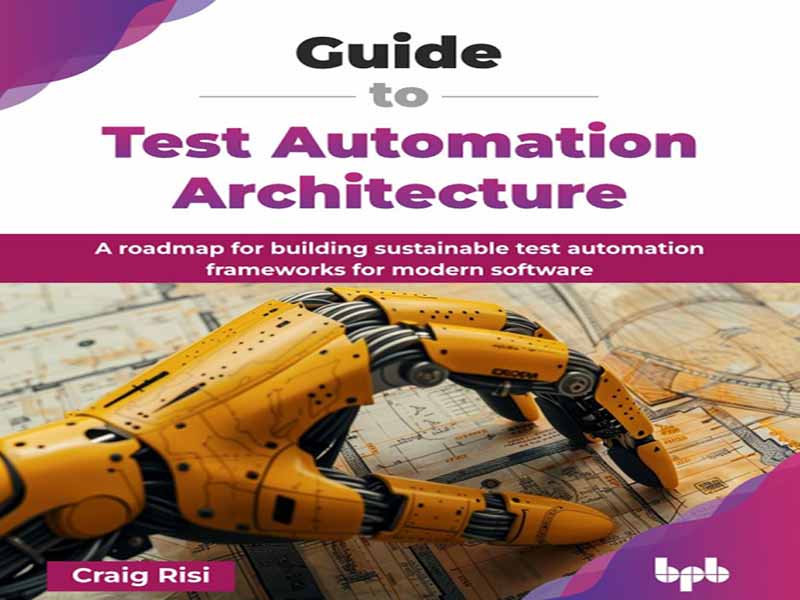- عنوان کتاب: Guide to Test Automation Architecture
- نویسنده: Craig Risi
- حوزه: DevOps
- سال انتشار: 2025
- تعداد صفحه: 815
- زبان اصلی: انگلیسی
- نوع فایل: pdf
- حجم فایل: 10.5 مگابایت
در چشمانداز پرشتاب توسعه نرمافزار امروزی، توانایی ارائه سریع و قابل اعتماد برنامههای کاربردی با کیفیت بالا، نه تنها یک مزیت رقابتی، بلکه یک ضرورت است. خودکارسازی تست به عنوان سنگ بنای توسعه مدرن و شیوههای DevOps ظهور کرده است، اما ارزش واقعی خودکارسازی نه تنها در نوشتن اسکریپتها، بلکه در ساخت چارچوبهای خودکارسازی قوی، مقیاسپذیر و قابل نگهداری است که میتوانند در کنار سیستمهایی که آزمایش میکنند، تکامل یابند. این کتاب حاصل سالها تجربه عملی، درسهای آموخته شده و گفتگو با متخصصان در صنایع مختلف است که با پیچیدگیهای تست سیستمهای نرمافزاری مدرن روبرو بودهاند. این کتاب برای معماران نرمافزار، مهندسان، SDETها و مهندسان کیفیت نوشته شده است که وظیفه ساخت چارچوبهای اتوماسیونی را دارند که فراتر از اصلاحات کوتاهمدت هستند و در عوض ارزش استراتژیک بلندمدت ارائه میدهند. این کتاب به جای تمرکز صرف بر ابزارها یا فناوریها – که همیشه در حال تغییر هستند – بر اصول بنیادی، استراتژیهای معماری و الگوهای طراحی عملی تأکید میکند که میتواند به شما در ایجاد چارچوبهای ابزارشناسی که قادر به سازگاری با الزامات، فناوریها و ساختارهای تیمی جدید هستند، کمک کند. این کتاب، دیدگاهی جامع از آنچه باعث موفقیت یک چارچوب میشود، از استانداردهای کدنویسی و مدیریت دادههای تست گرفته تا طراحی ماژولار، گزارشدهی، ادغام با خطوط لوله CI/CD و پایداری در طول زمان، ارائه میدهد. هدف من از این کتاب نه تنها ارائه راهنمایی، بلکه تشویق به تغییر طرز فکر است: دیدن توسعه چارچوب نه به عنوان یک کار یکباره، بلکه به عنوان یک تلاش مداوم در حال تکامل که از چابکی، قابلیت اطمینان و کیفیت در هر مرحله از تحویل نرمافزار پشتیبانی میکند. چه تازه سفر خود را در اتوماسیون آغاز کردهاید و چه به دنبال بهبود و نوسازی چارچوبهای موجود هستید، امیدوارم این کتاب هم به عنوان یک راهنمای عملی و هم به عنوان منبع الهامبخش عمل کند. فصل 1: مقدمهای بر اتوماسیون تست شرح: اتوماسیون تست به ستون فقرات تضمین کیفیت نرمافزار در محیطهای توسعه پرشتاب امروزی تبدیل شده است. این فصل نقش حیاتی آن را در توسعه نرمافزار مدرن و همسویی آن با اصول معماری نرمافزار بررسی میکند. تمرکز بر این است که چگونه اتوماسیون، زمان ورود به بازار را به حداقل میرساند و در عین حال کیفیت را تضمین میکند، چگونه چارچوبهای خوب طراحی شده هزینههای نگهداری را کاهش میدهند و چرا چارچوبهای مستقل از ابزار برای انعطافپذیری و مقیاسپذیری در اکوسیستمهای چند ابزاری ضروری هستند. فصل 2: درک چارچوبهای اتوماسیون تست شرح: یک پایه محکم با درک اینکه چارچوبهای اتوماسیون تست چیستند و چرا اهمیت دارند، آغاز میشود. این فصل به اجزای اصلی یک چارچوب میپردازد و انواع مختلف تست خودکار، از واحد و ادغام گرفته تا تست عملکرد و رابط کاربری را دستهبندی میکند. این فصل تأکید میکند که چگونه یک چارچوب با طراحی خوب، نتایج تست سازگار، تکرارپذیر و قابل اعتمادی را ارائه میدهد و در عین حال همکاری بین تیمهای مهندسی و QA را ممکن میسازد. فصل 3: طراحی با در نظر گرفتن معماری شرح: اصول معماری نرمافزار مانند مقیاسپذیری، قابلیت نگهداری و توسعهپذیری برای چارچوبهای تست به همان اندازه که برای توسعه برنامه مهم هستند، مهم هستند. این فصل در مورد اعمال الگوهای طراحی معماری – مانند ماژولارسازی، انتزاع و لایهبندی – برای چارچوبهای تست بحث میکند. همچنین بررسی میکند که چگونه الگوهای معماری مانند نما، آداپتور و ناظر میتوانند سازگاری چارچوب را افزایش داده و پیچیدگی را کاهش دهند. فصل 4: طراحی چارچوبهای تست ماژولار شرح: ماژولار بودن کلید ساخت چارچوبهای مقیاسپذیر و قابل نگهداری است. این فصل استراتژیهایی را برای جداسازی منطق تست، دادههای تست و پیکربندیها به اجزای مجزا و قابل استفاده مجدد تشریح میکند. این فصل بر اهمیت ایجاد چارچوبهای ماژولاری که به راحتی قابل گسترش و تطبیق با تغییر الزامات هستند، با مثالهای عملی از اجزای قابل استفاده مجدد برای گزارشدهی، مدیریت دادهها و هماهنگسازی تست تأکید میکند. فصل 5: تستپذیری و طراحی نرمافزار شرح: اتوماسیون تست زمانی مؤثرتر است که سیستمها با در نظر گرفتن تستپذیری طراحی شوند. این فصل بهترین شیوهها را برای ادغام تستپذیری در معماری نرمافزار، مانند تزریق وابستگی، رابطها و اتصال سست، معرفی میکند. همچنین مروری بر ابزارها و تکنیکهایی ارائه میدهد که سیستمهای پیچیده را قابل تستتر میکنند و تضمین میکنند که تلاشهای اتوماسیون کارآمد و قابل اعتماد باقی میمانند. فصل 6: هماهنگسازی و اجرای تست شرح: قلب هر چارچوب اتوماسیون تست، قابلیتهای هماهنگسازی و اجرای آن است. این فصل توضیح میدهد که چگونه یک اجراکننده تست سفارشی طراحی کنید که از مدیریت مجموعههای تست، مدیریت اجرای موازی و تولید گزارشهای دقیق پشتیبانی کند. همچنین در مورد زمانبندی تستها و هماهنگی اجرا در محیطهای مختلف برای حداکثر کارایی بحث میکند. فصل 7: مدیریت دادههای تست شرح: مدیریت دادههای تست یکی از چالشبرانگیزترین جنبههای اتوماسیون است. این فصل استراتژیهای تولید، ذخیرهسازی و مدیریت دادههای تست، از جمله تکنیکهایی برای حفظ سازگاری در محیط تست را بررسی میکند.
In today’s fast-paced software development landscape, the ability to deliver high-quality applications rapidly and reliably is not just a competitive advantage—it is a necessity. Test automation has emerged as a cornerstone of modern development and DevOps practices, but the true value of automation lies not merely in writing scripts, but in building robust, scalable, and maintainable automation frameworks that can evolve alongside the systems they test. This book was born out of years of hands-on experience, lessons learned, and conversations with practitioners across industries who have faced the complexities of testing modern software systems. It is written for software architects, engineers, SDETs, and quality engineers who are tasked with building automation frameworks that go beyond short-term fixes and instead provide long-term strategic value. Rather than focusing solely on tools or technologies—which are everchanging— this book emphasizes foundational principles, architectural strategies, and practical design patterns that can help you create toolagnostic frameworks capable of adapting to new requirements, technologies, and team structures. It provides a holistic view of what makes a framework succeed, from coding standards and test data management to modular design, reporting, integration with CI/CD pipelines, and sustainability over time. My goal with this book is not only to provide guidance, but also to encourage a mindset shift: to see framework development not as a one-time task, but as a continuously evolving effort that supports agility, reliability, and quality at every stage of software delivery. Whether you are just beginning your journey in automation or looking to improve and modernize existing frameworks, I hope this book serves as both a practical guide and a source of inspiration. Chapter 1: Introduction to Test Automation Description: Test automation has become the backbone of software quality assurance in today’s fast-paced development environments. This chapter examines its critical role in modern software development and its alignment with software architecture principles. The focus is on how automation minimizes time-to-market while ensuring quality, how well-designed frameworks reduce maintenance costs, and why tool-agnostic frameworks are essential for flexibility and scalability in multi-tool ecosystems. Chapter 2: Understanding Test Automation Frameworks Description: A solid foundation begins with understanding what test automation frameworks are and why they matter. This chapter delves into the core components of a framework and categorizes various types of automated testing, from unit and integration to performance and UI testing. It emphasizes how a well-designed framework provides consistent, repeatable, and reliable testing outcomes while enabling collaboration across engineering and QA teams. Chapter 3: Designing with Architecture in Mind Description: Software architecture principles like scalability, maintainability, and extensibility are as important for testing frameworks as they are for application development. This chapter discusses applying architectural design patterns—such as modularization, abstraction, and layering—to test frameworks. It also explores how architectural patterns like the Facade, Adapter, and Observer can enhance the framework’s adaptability and reduce complexity. Chapter 4: Designing Modular Test Frameworks Description: Modularity is the key to building scalable and maintainable frameworks. This chapter outlines strategies for separating test logic, test data, and configurations into distinct, reusable components. It emphasizes the importance of creating modular frameworks that are easy to extend and adapt as requirements change, with practical examples of reusable components for reporting, data management, and test orchestration. Chapter 5: Testability and Software Design Description: Test automation is most effective when systems are designed with testability in mind. This chapter introduces best practices for integrating testability into software architecture, such as dependency injection, interfaces, and loose coupling. It also provides an overview of tools and techniques that make complex systems more testable, ensuring automation efforts remain efficient and reliable. Chapter 6: Test Orchestration and Execution Description: The heart of any test automation framework is its orchestration and execution capabilities. This chapter explains how to design a custom test runner that supports managing test suites, handling parallel execution, and generating detailed reports. It also discusses scheduling tests and coordinating execution across environments for maximum efficiency. Chapter 7: Test Data Management Description: Managing test data is one of the most challenging aspects of automation. This chapter explores strategies for test data generation, storage, and management, including techniques for maintaining consistency across test environments using mocks, stubs, and other state management tools. It also covers the principles of data-driven testing to ensure frameworks can handle diverse inputs and configurations seamlessly. Chapter 8: CI/CD Integration and Quality Gates Description: This chapter explains how to embed test automation frameworks into CI/CD pipelines to accelerate software delivery. It provides practical steps for automating test execution as part of the build process and implementing quality gates to enforce standards for build success. The chapter also highlights how to ensure smooth integration with popular CI tools like Jenkins, GitHub Actions, or Azure Pipelines. Chapter 9: Handling Asynchronous and Distributed Systems Description: Modern software systems are often asynchronous and distributed, posing unique challenges for test automation. This chapter examines strategies for testing microservices, event-driven architectures, and distributed systems. It explores techniques for managing dependencies, orchestrating complex workflows, and addressing common pitfalls in testing asynchronous components. Chapter 10: Security, Performance, and Resilience Testing Description: Test automation frameworks must extend beyond functional testing to cover critical cross-cutting concerns. This chapter demonstrates how to integrate security, performance, and resilience testing into the same tool-agnostic framework. It discusses embedding chaos testing practices to validate system robustness and using performance tools to measure and optimize system throughput and latency. Chapter 11: Overview of Tools Used in Test Automation Description: In this chapter we analyze the different types of popular test automation tools that are available on the market. We will start off by looking at criteria to evaluate and help teams identify the best approach to selecting the right tool for their use case, before diving into the pros and cons of many different tools – at both a functional and performance testing area. Chapter 12: Case Study: Building a Scalable Framework From Scratch Description: Through a practical example, this chapter walks readers through the step-by-step implementation of a test automation framework. From defining initial requirements to making architectural decisions and solving key challenges, this case study provides an in-depth look at what it takes to build a scalable, tool-agnostic framework from the ground up. Chapter 13: Case Study: Migrating to a Tool-agnostic Framework Description: Transitioning from a tool-specific to a tool-agnostic framework comes with its own challenges and lessons. This chapter shares a real-world case study of how a team successfully migrated their legacy framework, detailing their strategy, solutions to technical hurdles, and the approach taken to win team adoption and maintain seamless operations during the transition. Chapter 14: Case Study: Framework Evolution and Continuous Improvement Description: The journey of test automation frameworks does not end with their initial implementation. This chapter examines how frameworks can evolve over time to adapt to new requirements and technologies. It discusses strategies for managing technical debt, balancing incremental updates with long-term architectural improvements, and fostering continuous improvement through feedback loops and monitoring. Chapter 15: Embracing AI and ML in Test Automation Description: Artificial intelligence and machine learning are transforming test automation. This chapter explores how AI-driven tools can enhance test case generation, test selection, and execution. It also covers machine learning techniques for identifying flaky tests and using predictive models to improve test stability. Chapter 16: Emerging Trends and Technologies Description: The future of test automation frameworks lies in embracing emerging technologies. This chapter highlights trends such as serverless computing, containerized architectures, and cloud-native testing tools. It offers insights into how frameworks can adapt to modern architectures and stay relevant in a rapidly evolving technological landscape. Chapter 17: Conclusion: The Path to Sustainable Test Automation Frameworks Description: The book concludes with a reflection on the importance of designing test automation frameworks with scalability, flexibility, and sustainability in mind. It emphasizes the need for continuous learning, iterative improvements, and fostering collaboration between engineering, QA, and DevOps teams. By applying the principles and strategies outlined in this book, readers can create frameworks that not only meet current testing needs but also evolve to handle the challenges of the future.
این کتاب را میتوانید از لینک زیر بصورت رایگان دانلود کنید:
Download: Guide to Test Automation Architecture



































نظرات کاربران